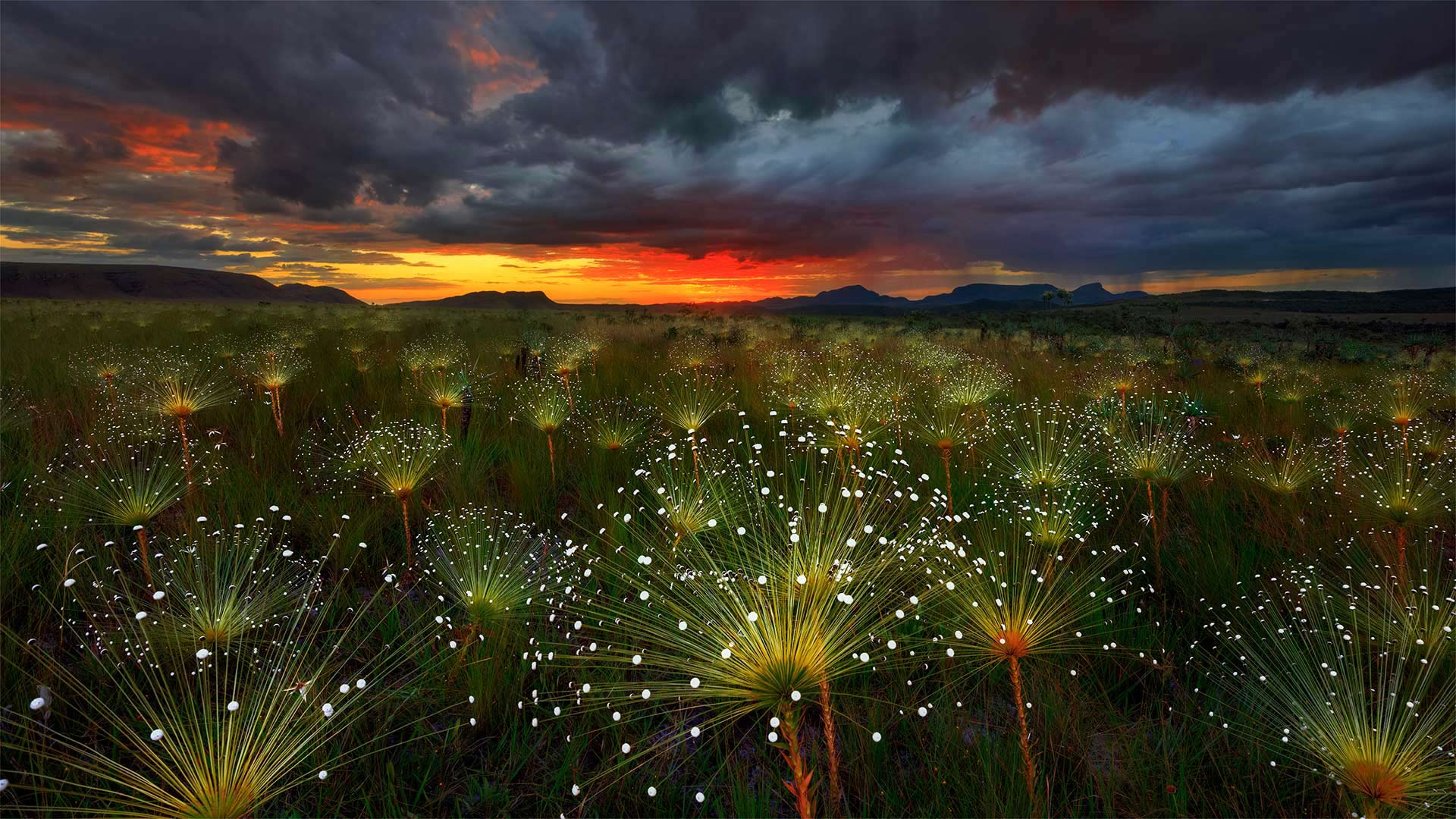内格罗河,亚马逊河流域,巴西 Río Negro, Amazon basin, Brazil (© Timothy Allen/Getty Images)
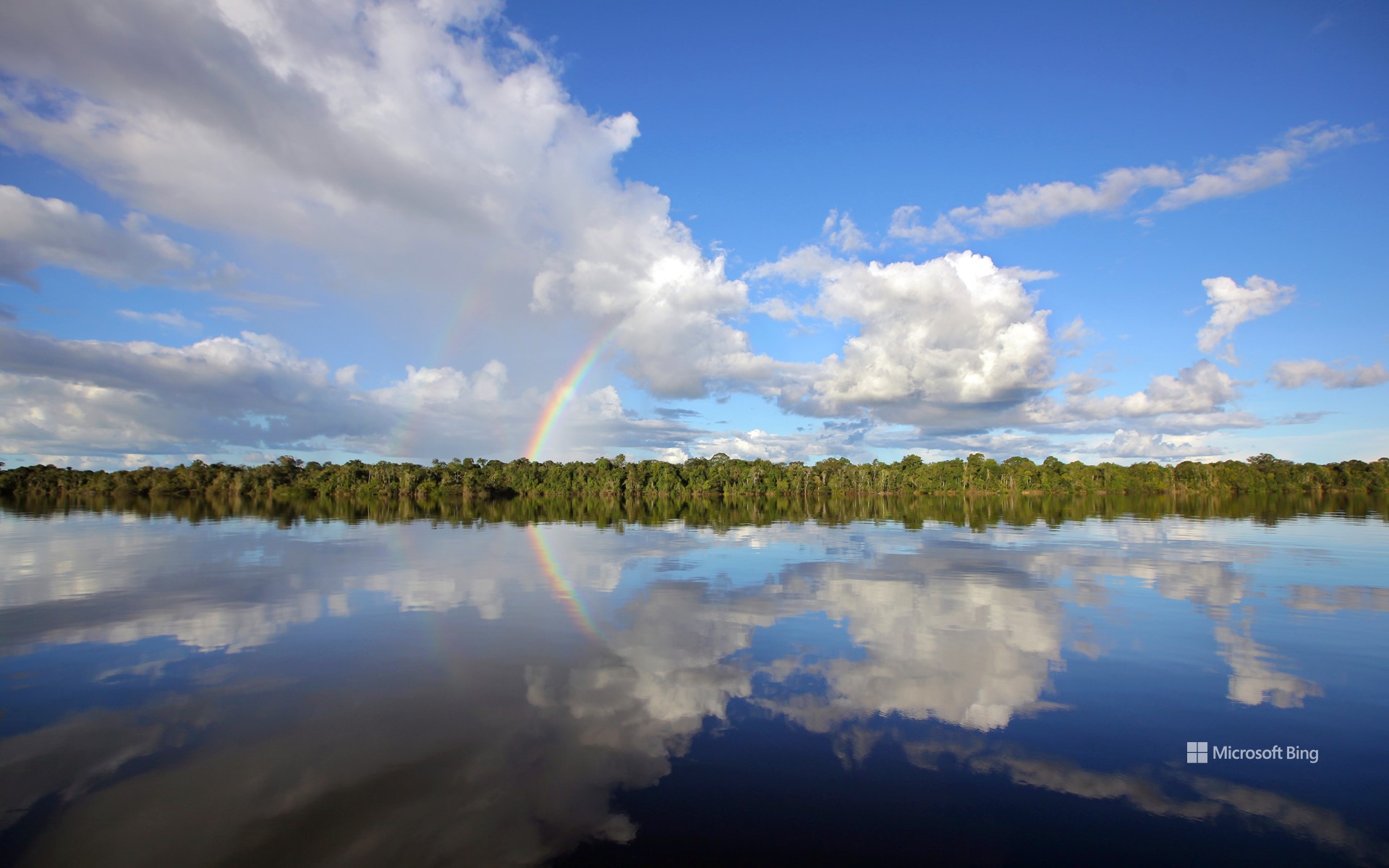
内格罗河,亚马逊河流域,巴西 Río Negro, Amazon basin, Brazil (© Timothy Allen/Getty Images)
水上明镜 Mirror, mirror, on the water
内格罗河,亚马逊河流域,巴西
内格罗河起源于哥伦比亚,是亚马逊河的支流之一。在西班牙语中,
内格罗河(Río
Negro)的意思是“黑色的河”,因为从远处看它,河水是黑色的。但走进观看,其河面平静如镜,就如图中所展示的那样,可以倒映出蔚蓝的天空以及彩虹的颜色。内格罗河的河水之所以是黑色的,是因为附近沼泽中渗出了有机物分解时产生的高浓度腐殖酸。作为亚马逊河北岸最大的支流之一,内格罗河在复杂的亚马逊流域生态系统中发挥着至关重要的作用。它也是许多动植物的家园,比如极度濒危的黑白柽柳猴、巴西巨獭以及近700种鱼类。
Río Negro, Amazon basin, Brazil
From its source in Colombia, the Río Negro flows about 1,400 miles to become one of the largest tributaries of the Amazon River at the Meeting of Waters in Manaus, Brazil. It is also the largest blackwater river in the world, its water stained by decomposing organic matter that seeps in from swamps. These slow-moving, dark waters beautifully reflect the colors of the sky, including the rainbows which form over the Amazon basin, as seen here. The river also plays a crucial role in the ecosystem, as the home of many plants and animals, including the critically endangered Brazilian barefaced tamarin, the giant river otter, and nearly 700 species of fish.
Itaimbezinho峡谷,巴西 Itaimbezinho canyon, Brazil (© NidoHuebl/Getty Images)
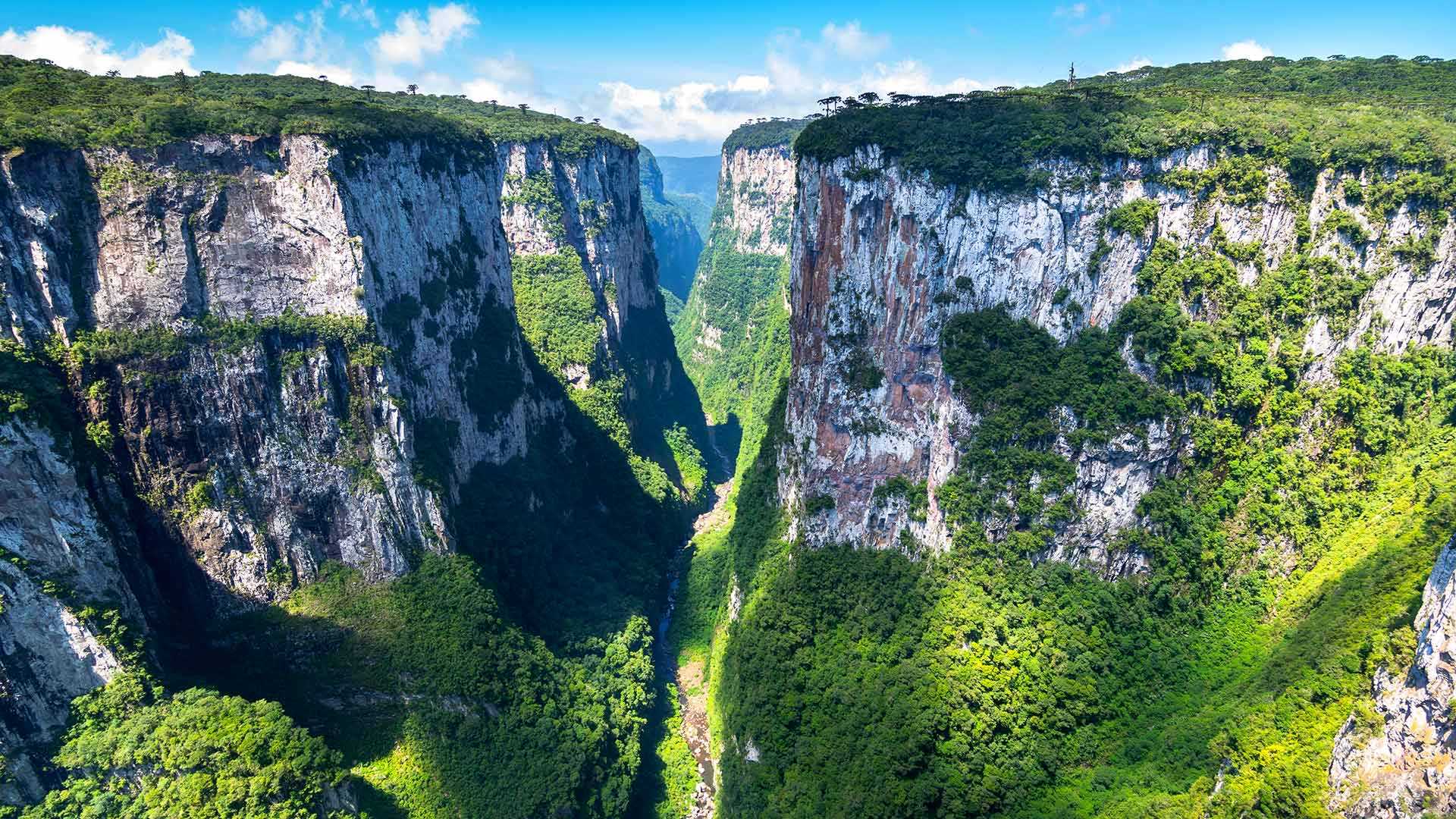
Itaimbezinho峡谷,巴西 Itaimbezinho canyon, Brazil (© NidoHuebl/Getty Images)
在大自然中漫步 Walk in nature
Itaimbezinho峡谷,巴西
Itaimbezinho
峡谷是南里奥格兰德州最著名的峡谷。它是巴西自然奇观之一,位于南坎巴拉市,它是巴西南坎巴拉市的自然奇观之一,位于阿帕拉多斯达塞拉国家公园内。Itaimbezinho峡谷两侧的峭壁非常直,如刀切一般。Itaimbezinho峡谷名字便得名于峭壁的特征,在图皮瓜拉尼语中:"ita"的意思是石头,"aimbé"的意思是切割和锋利。
Itaimbezinho canyon, Brazil
The Itaimbezinho Canyon is the most famous canyon in the state of Rio Grande do Sul. It is one of the natural wonders of Brazil in the city of Cambará do Sul, located in the Aparados da Serra National Park. Itaimbezinho has extremely straight walls that give the impression of having been cut with a knife. This characteristic gave rise to the name, in Tupi Guarani: "ita" means stone, and "aimbé" means cutting and sharp. The region of the canyons was also the habitat of the Indians and has also been the scene of several soap operas and miniseries.
亚马逊河鸟瞰图,巴西 Aerial view of the Amazon River in Brazil (© Curioso.Photography/Shutterstock)
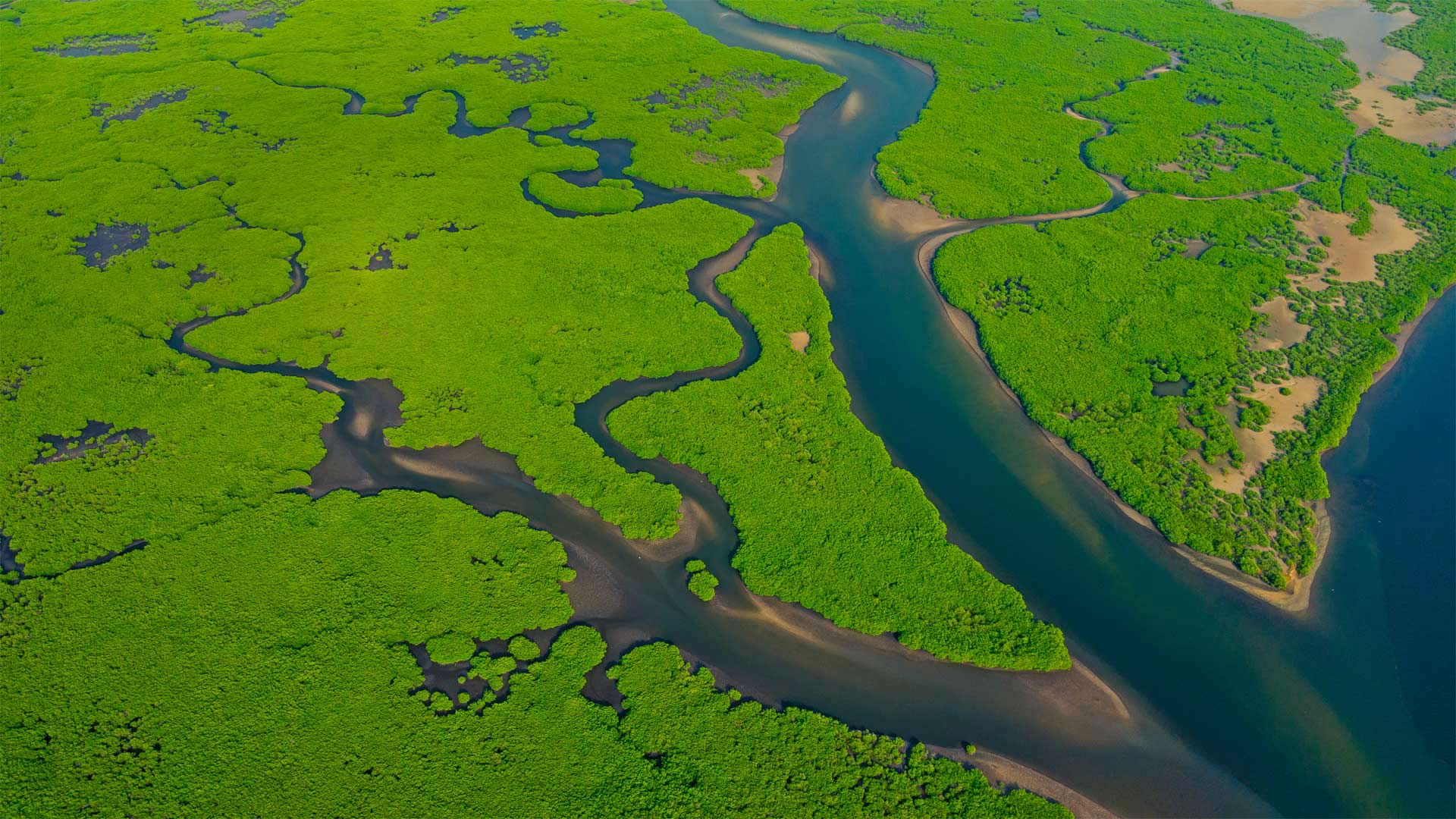
亚马逊河鸟瞰图,巴西 Aerial view of the Amazon River in Brazil (© Curioso.Photography/Shutterstock)
匆匆而逝的河流 The rivers run through us
World Rivers Day
On World Rivers Day, we honor what may be thought of as the queen of them all—the Amazon, which flows more than 4,000 miles mostly through the South American countries of Peru and Brazil. The Amazon discharges a whopping 58 million gallons of fresh water into the ocean every second, enough to fill 83 Olympic-sized swimming pools, far more water than any other river in the world. It accounts for 20% of all fresh water that flows into the world's seas and oceans. It's also the vital heart of the largest and most diverse rain forest in the world—the Amazon Rain Forest is home to a third of the world's animal species and its trees and plants pull billions of tons of heat-trapping carbon dioxide from the atmosphere each year, making it one of the Earth's best defenses against climate change.
Mark Angelo, a river conservationist from British Columbia, launched World Rivers Day in 2005 to recognize the importance of rivers to the survival of humanity and millions of species all over the world. Rivers are our best source of fresh water, they can be an important energy source, they're the foundations of complex ecosystems, and provide crucial sources of irrigation for our crops, among other contributions to our way of life. Besides, who doesn't love a float down a lazy river?
世界河流日
在世界河流日,我们向可能被认为是所有河流中的女王的亚马逊河致敬,该河流经4000多英里,主要流经南美国家秘鲁和巴西。亚马逊河每秒向海洋排放5800万加仑的淡水,足以填满83个奥运会规模的游泳池,远远超过世界上任何其他河流。它占流入世界海洋的所有淡水的20%。亚马逊雨林是世界上最大、种类最多的雨林的重要心脏,是世界三分之一动物物种的家园,其树木和植物每年从大气中吸收数十亿吨的吸热二氧化碳,使其成为地球抵御气候变化的最佳防御措施之一。
来自不列颠哥伦比亚省的河流保护主义者马克·安吉洛(Mark Angelo)于2005年发起了世界河流日活动,以认识到河流对全世界人类和数百万物种生存的重要性。河流是我们最好的淡水来源,它们可以是重要的能源,是复杂生态系统的基础,为我们的作物提供重要的灌溉资源,以及对我们生活方式的其他贡献。此外,谁不喜欢沿着懒惰的河流漂流?
明天博物馆, 巴西里约热内卢 Museu do Amanhã (Museum of Tomorrow) in Rio de Janeiro, Brazil (© Nido Huebl/Shutterstock)
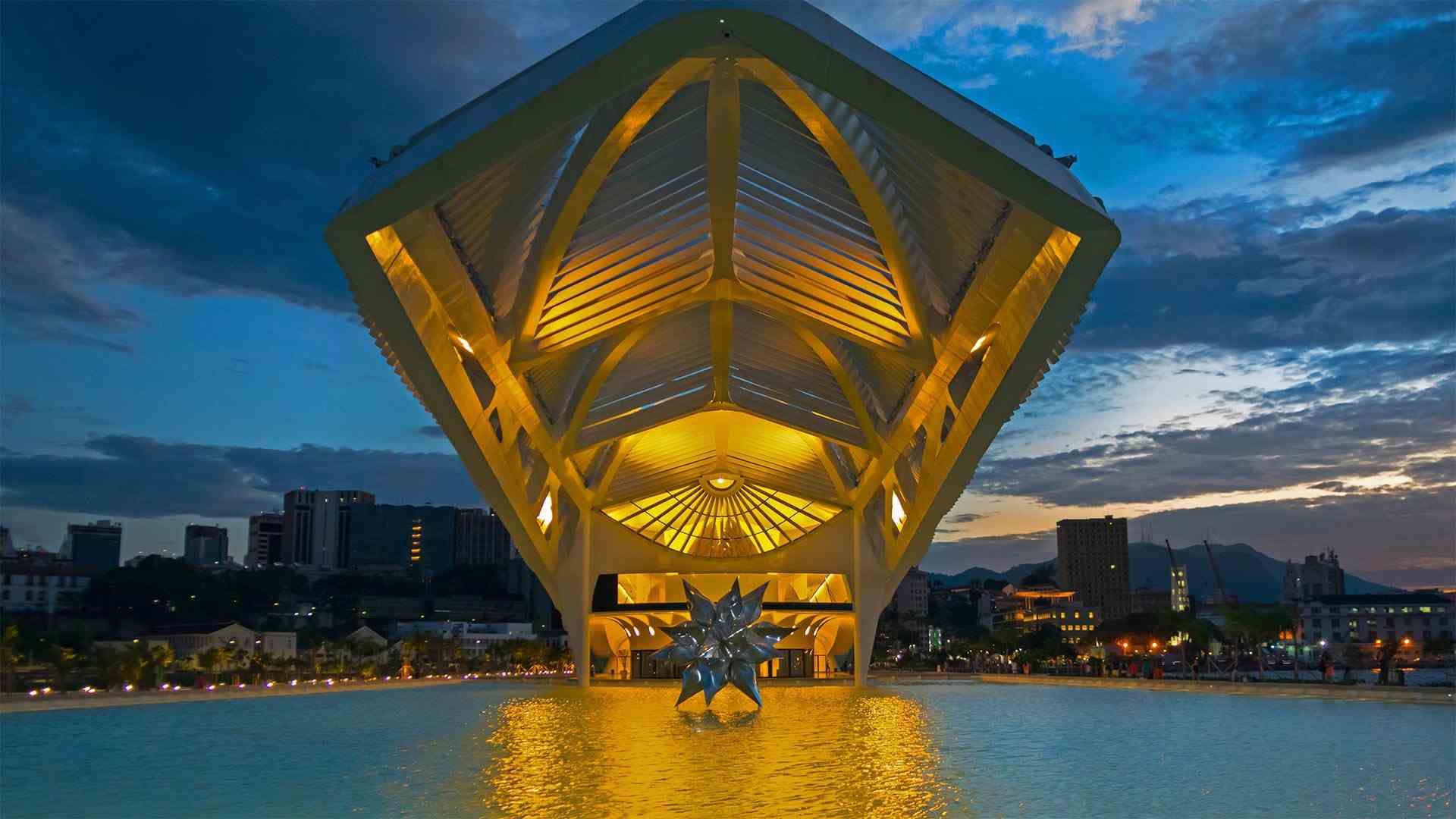
明天博物馆, 巴西里约热内卢 Museu do Amanhã (Museum of Tomorrow) in Rio de Janeiro, Brazil (© Nido Huebl/Shutterstock)
Back to the future 回到未来
200th anniversary of Brazilian independence
Today we visit the Museu do Amanhã (Museum of Tomorrow) in Rio de Janeiro to celebrate 200 years of Brazilian independence. Designed by Spanish neofuturist architect Santiago Calatrava, the unique structure was commissioned to showcase Rio's revitalized waterfront ahead of the 2016 Olympics. The museum comprises five main areas: Cosmos, Earth, Anthropocene, Tomorrow, and Us, each inviting visitors to interact in different ways and learn about living in a sustainable world.
Brazil gained independence from Portugal just a few decades after the United States broke off from Great Britain, though it happened in a decidedly different way. Don Pedro I, first emperor of Brazil, was a member of the Portuguese ruling family (he would eventually briefly rule Portugal too). When Portugal threatened to take back the political autonomy Brazil had enjoyed since 1808, Pedro sided with his adopted homeland against the Portuguese. After a three-year war that was largely bloodless, the Empire of Brazil, which preceded the vibrantly diverse democracy we know today, was born on September 7, 1822.
巴西独立200周年
今天,我们参观了里约热内卢的明天博物馆(Museu do Amanhã),以庆祝巴西独立200周年。由西班牙新未来主义建筑师圣地亚哥·卡拉特拉瓦(Santiago Calatrava)设计,这座独特的建筑被委托在2016年奥运会之前展示里约复兴的滨水区。博物馆由五个主要区域组成:宇宙、地球、人类世、明天和我们,每个区域都邀请游客以不同的方式互动,了解如何生活在一个可持续发展的世界中。
在美国脱离英国之后的几十年里,巴西从葡萄牙获得了独立,尽管这是以一种截然不同的方式发生的。巴西第一位皇帝唐·佩德罗一世是葡萄牙统治家族的成员(他最终也将短暂统治葡萄牙)。当葡萄牙威胁要夺回巴西自1808年以来享有的政治自治权时,佩德罗站在自己的祖国一边反对葡萄牙人。在经历了一场三年的基本上不流血的战争后,巴西帝国于1822年9月7日诞生,它先于我们今天所知的充满活力的多元化民主。
格洛里亚附近的码头和糖面包山,巴西里约热内卢 Marina da Glória and Sugarloaf Mountain, Rio de Janeiro, Brazil (© f11photo/Getty Images)
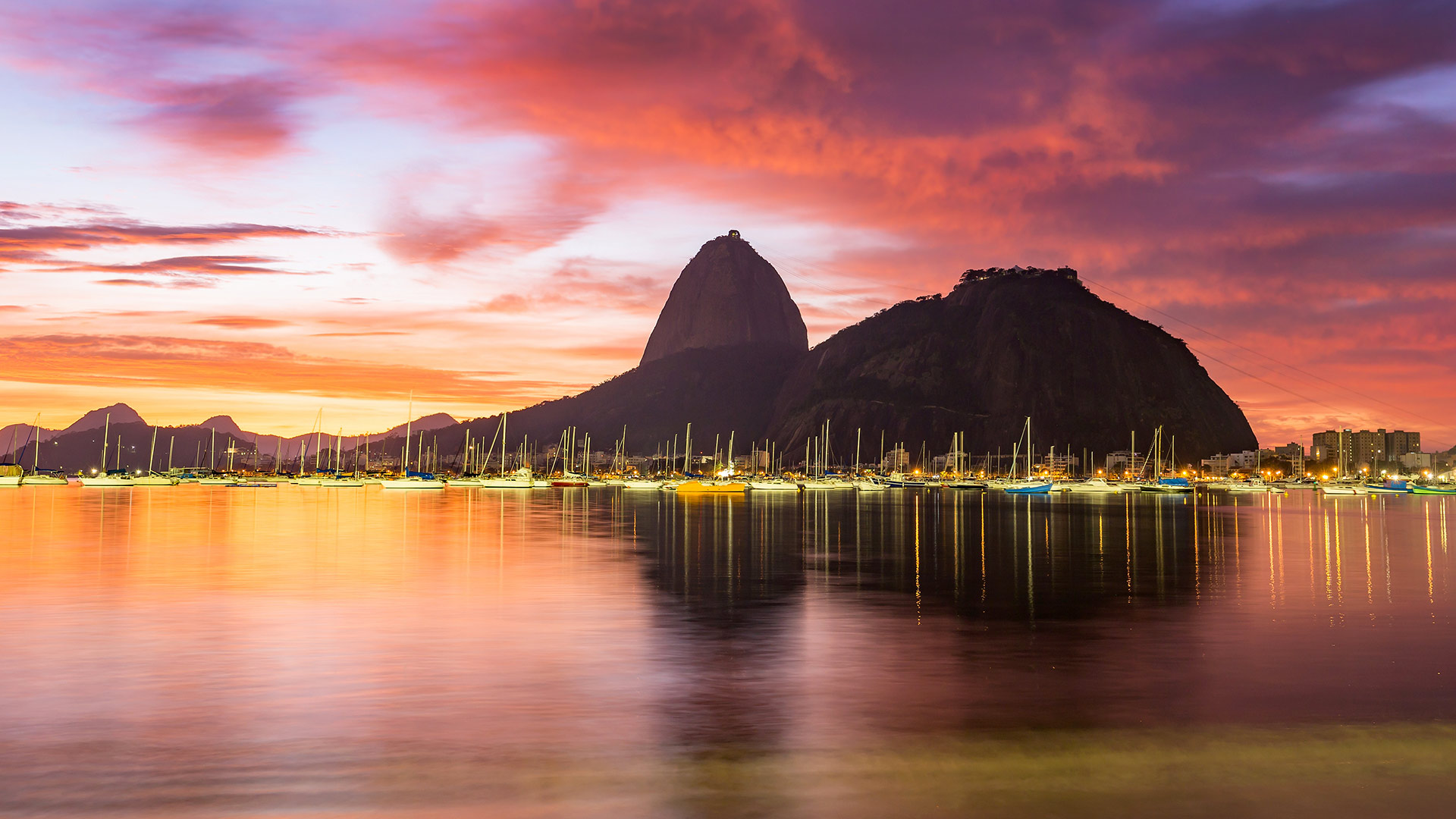
格洛里亚附近的码头和糖面包山,巴西里约热内卢 Marina da Glória and Sugarloaf Mountain, Rio de Janeiro, Brazil (© f11photo/Getty Images)
里约热内卢的象征 The symbols of Rio
Sugarloaf Mountain
Perhaps one of the most internationally recognized parts of Brazil, Sugarloaf Mountain overlooks the surrounding waters of Guanabara Bay and the bustling city of Rio de Janeiro. A famous cable car connects Urca – the first hill (215 metres) on the way up to Sugarloaf Mountain – with the mountain itself, which reaches a height of 396 metres above the harbour. Together they form the Sugarloaf Mountain and Urca Hill Natural Monument which, along with the Christ the Redeemer statue, are the city's most famous postcard images. The vehicle, which also connects the two hills to Praia Vermelha, was conceived in 1908 and opened in 1912. It was the first cable car in the country and the third in the world.
In today's image, the impressive mountain scenery and docked yachts are reflected in the waters of Marina da Glória. Nestled between Sugarloaf and Corcovado Mountains, Marina da Glória is one of the city’s most popular waterfront destinations. The venue hosted sailing competitions at the Rio 2016 Olympic and Paralympic Games and now receives around 1.3 million visitors a year. The marina is one of South America’s premier charter destinations and can accommodate yachts measuring up to 60 meters in length. From here you can explore Flamengo Park, the largest public park and recreation area within the city, as well as enjoy some of the best views of Sugarloaf Mountain.
糖面包山
糖面包山可能是巴西最受国际认可的地区之一,它可以俯瞰瓜纳巴拉湾周围的水域和繁华的里约热内卢市。一辆著名的缆车将乌尔卡(Urca)——通往糖面包山(Sugarloaf Mountain)的第一座山(215米)——与港口上方396米的山相连。它们一起形成了糖面包山和乌尔卡山自然纪念碑,与救世主基督雕像一起,是该市最著名的明信片图像。这辆车也连接了两座山和普拉亚·维梅尔哈(Praia Vermelha),设计于1908年,并于1912年投入使用。这是该国第一辆缆车,也是世界第三辆缆车。
在今天的图片中,令人印象深刻的山景和停靠的游艇反映在Marina da Glória的水域中。Marina da Glória位于Sugarloaf和Corcovado山脉之间,是该市最受欢迎的海滨目的地之一。该场馆举办了2016年里约奥运会和残奥会的帆船比赛,目前每年接待约130万游客。码头是南美洲主要的租船目的地之一,可容纳长达60米的游艇。从这里,您可以探索弗拉门戈公园,这是市内最大的公共公园和娱乐区,还可以欣赏到糖面包山的一些最佳景色。
大自然的水族馆中的水下景观,巴西 Underwater river scene with freshwater plants and tetra fish, Aquário Natural, Rio Baia Bonito, Mato Grosso do Sul, Brazil (© Michel Roggo/Minden Pictures)
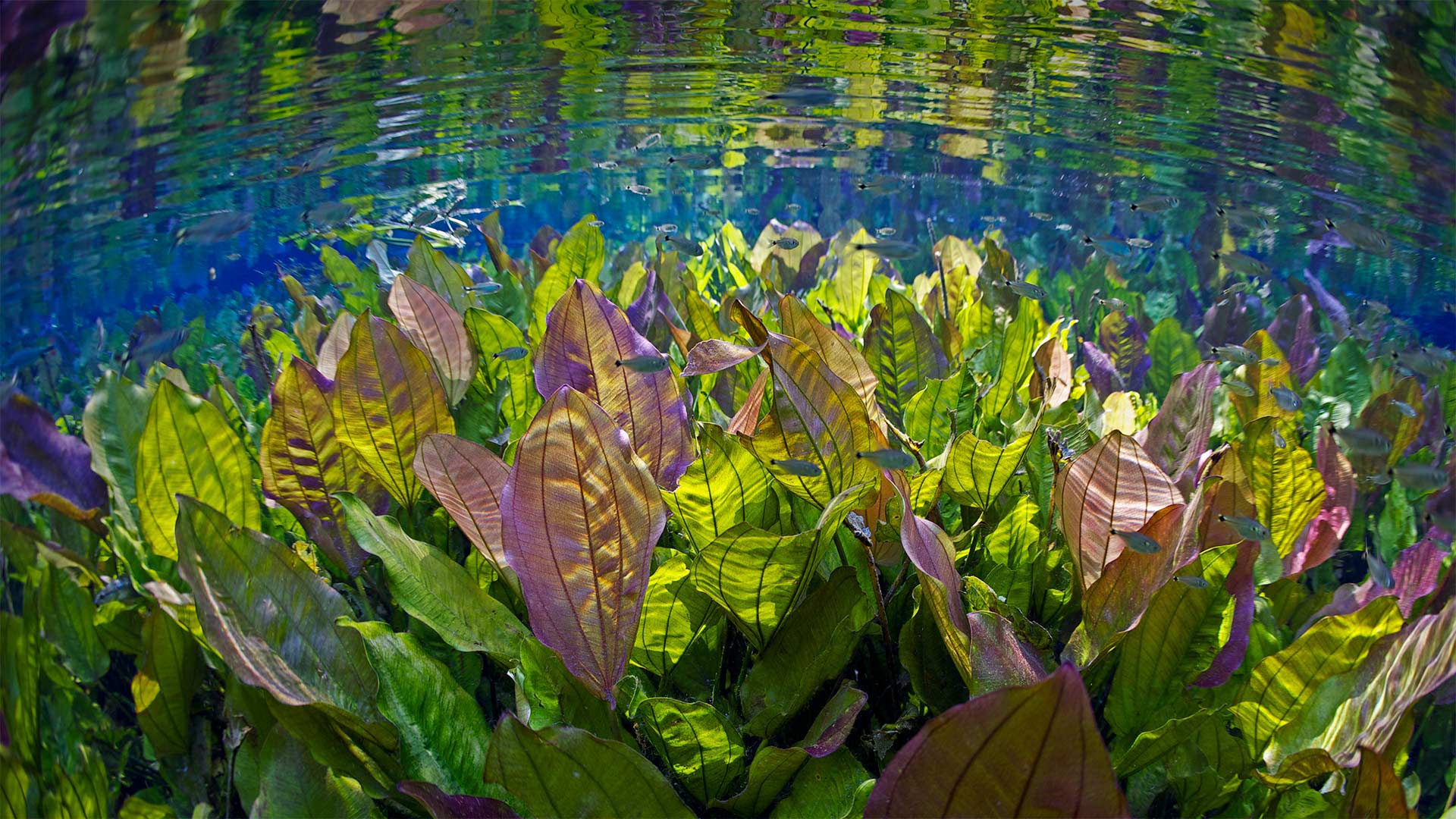
大自然的水族馆中的水下景观,巴西 Underwater river scene with freshwater plants and tetra fish, Aquário Natural, Rio Baia Bonito, Mato Grosso do Sul, Brazil (© Michel Roggo/Minden Pictures)
如此清澈,如此洁净 So fresh, so clean
Freshwater plants in Aquario Natural, Brazil
Aquário Natural (Natural Aquarium, naturally) is the pristine, crystal-clear source of the Baía Bonita River and a highlight of the Baía Bonita Ecological Reserve. This remote inland region of Brazil is a popular spot for eco-tourism. A tour of the Aquário Natural offers a hike through the jungle followed by snorkeling with over 30 varieties of fish and gorgeous vegetation to marvel at. Other popular activities of the area include swimming the Silver River, rappelling 236 feet down into the waters of the Anhumas Abyss, and walking through the treetops on the suspended steel walkway of the Circuito Arvorismo (The Trees Circuit).
The underwater scene in today's image of plants and tetra fish was photographed by Swiss artist Michel Roggo. Since 2010, Roggo has crisscrossed the world in search of the most beautiful freshwater environments. His work has taken him to 48 locations where he has taken more than 12,000 photographs. His projects highlight the need to protect unsullied locations and to safeguard the world's wetlands and freshwater ecosystems.
巴西Aquario Natural的淡水植物
阿奎里奥自然水族馆(Natural Aquario,Natural)是巴尼亚博尼塔河的原始、清澈的源头,也是巴尼亚博尼塔生态保护区的一大亮点。巴西这个偏远的内陆地区是生态旅游的热门景点。阿奎里奥自然之旅提供了一次穿越丛林的徒步旅行,然后是30多种鱼类和华丽植被的浮潜。该地区其他受欢迎的活动包括在银河上游泳,用绳索将236英尺的水降到Anhumas深渊的水中,以及在Circuito Arvorismo(树木赛道)的悬挂式钢制走道上穿过树梢。
今天的植物和鱼类图片中的水下场景是由瑞士艺术家米歇尔·罗格拍摄的。自2010年以来,罗格在世界各地寻找最美丽的淡水环境。他的工作带他去了48个地方,在那里他拍了12000多张照片。他的项目强调了保护无污染地点和保护世界湿地和淡水生态系统的必要性。
上弗洛雷斯塔附近晨雾中亚马逊雨林,巴西马托格罗索 Amazon rainforest with fog in the morning near Alta Floresta, Mato Grosso, Brazil (© Pulsar Imagens/Alamy)
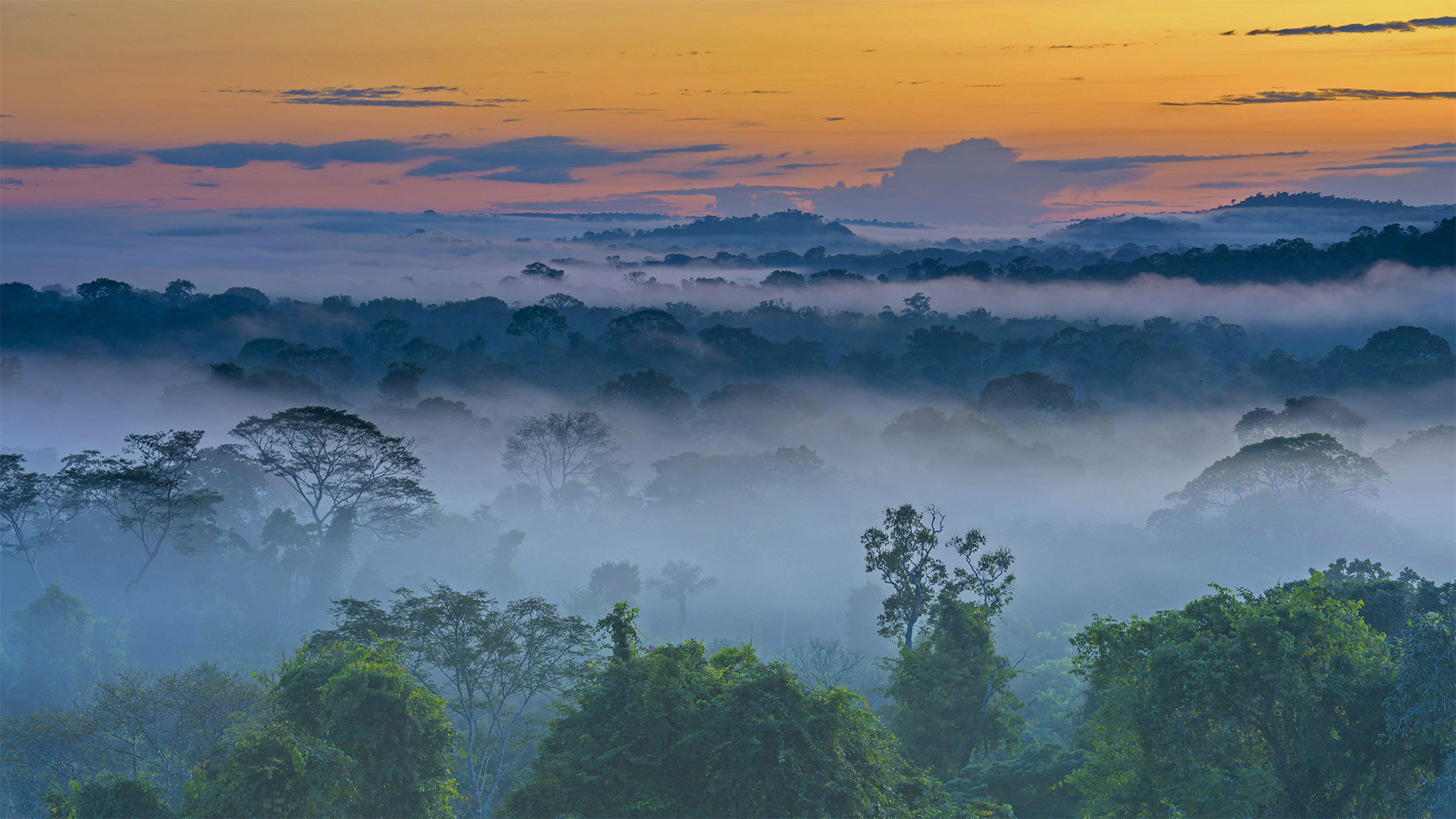
上弗洛雷斯塔附近晨雾中亚马逊雨林,巴西马托格罗索 Amazon rainforest with fog in the morning near Alta Floresta, Mato Grosso, Brazil (© Pulsar Imagens/Alamy)
A misty morning in Brazil
The Amazon rainforest is big. Almost unimaginably big. To begin to grasp its immensity, consider these numbers: The Amazon rainforest covers about 2% of the world's surface area, nearly 2.1 million square miles across South America, mostly (nearly 60%) in the country you see here, Brazil. It's an area that accounts for over half the Earth's remaining rainforests. The breadth of biodiversity is incomparable–nearly 16,000 different tree species, 40,000 species of other plants, 2.5 million insect species, and over 2,000 different types of birds and mammals. Incredibly, perhaps a tenth of the planet's known species call the Amazon home, many of which have not even been identified.
Yet, despite its vastness and ecological riches, the Amazon and the world's rainforests in general are in jeopardy, with large swaths of these precious environments being stripped and spoiled every day. Recent analysis has revealed some ominous warning signs that the Amazon rainforest, long known as the 'Lungs of the World,' is now spewing out as much greenhouse gas as it can store because of rampant deforestation here. If true, this is a bad sign in our battle against climate change. Hopefully, these warnings will raise awareness about the importance of rainforests, and the vital 'carbon sink' role they play in creating and maintaining the air that we breath. The more we learn about rainforests, the more we appreciate how our own future, and the future of our planet, hinges upon their health.
巴西雾蒙蒙的早晨
亚马逊雨林很大。几乎难以想象的大。要开始理解它的浩瀚,考虑一下这些数字:亚马逊雨林覆盖了大约2%的世界表面积,几乎210万平方英里横跨南美洲,大部分(近60%)在你看到的国家,巴西。这个地区占了地球剩余雨林的一半以上。生物多样性的广度是无与伦比的——将近16000种不同的树种,40000种其他植物,250万种昆虫,2000多种不同类型的鸟类和哺乳动物。令人难以置信的是,地球上大约十分之一的已知物种称亚马逊为家,其中许多物种甚至还没有被确认。
然而,尽管亚马逊地区幅员辽阔,生态资源丰富,但它和整个世界的雨林都处于危险之中,大片宝贵的环境每天都被剥夺和破坏。最近的分析揭示了一些不祥的警告信号,长期以来被称为“世界之肺”的亚马逊雨林,由于这里森林砍伐猖獗,现在正喷出尽可能多的温室气体。如果这是真的,那么这是我们应对气候变化斗争中的一个坏迹象。希望这些警告能提高人们对雨林重要性的认识,以及它们在创造和维持我们呼吸的空气中所起的重要“碳汇”作用。我们对雨林了解得越多,我们就越了解我们自己的未来,以及我们星球的未来如何取决于它们的健康。
伦索伊斯马拉年塞斯国家公园,巴西巴雷里尼亚斯市 Lençóis Maranhenses National Park in Barreirinhas, Brazil (© WIN-Initiative/Getty Images)
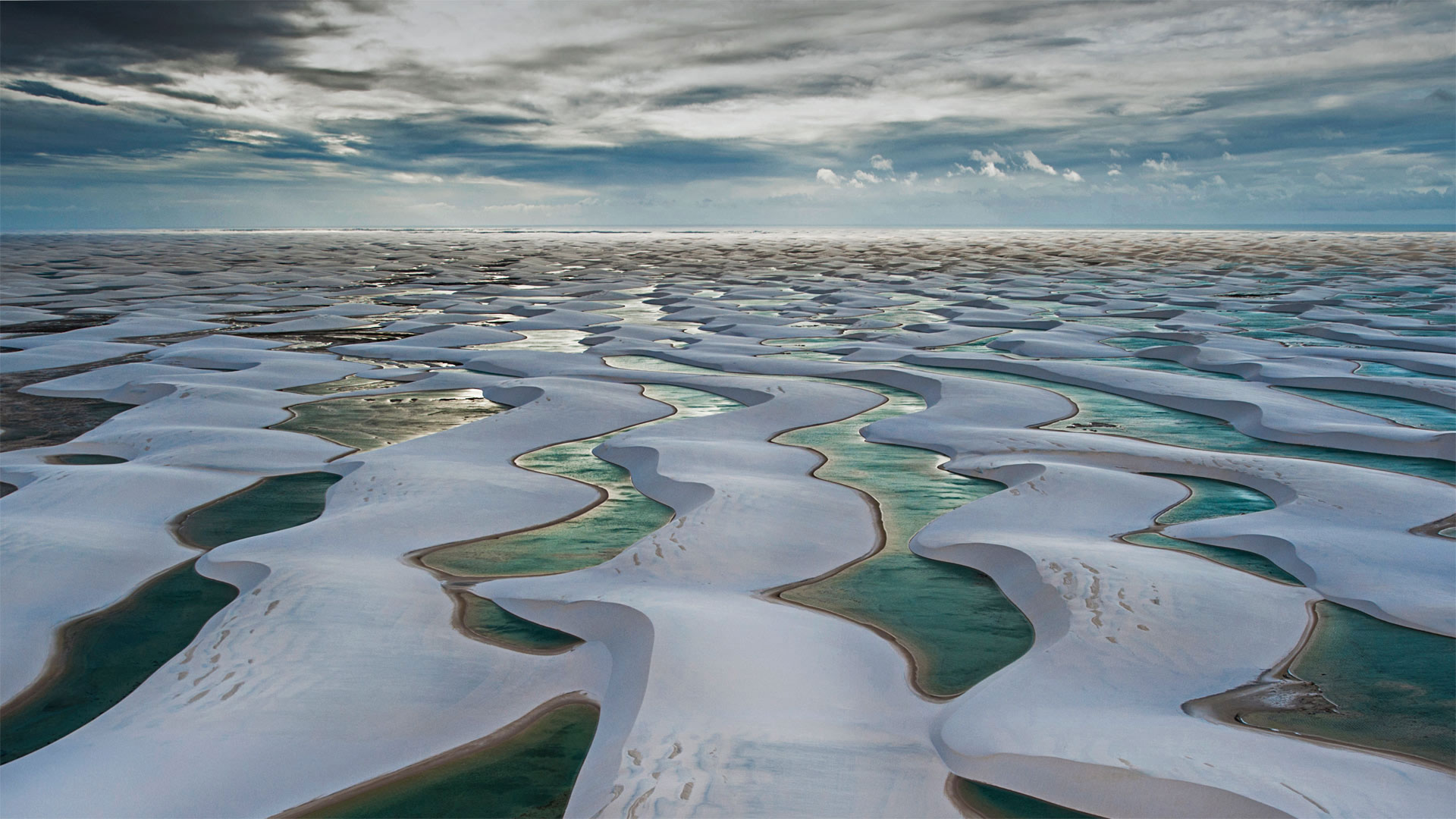
伦索伊斯马拉年塞斯国家公园,巴西巴雷里尼亚斯市 Lençóis Maranhenses National Park in Barreirinhas, Brazil (© WIN-Initiative/Getty Images)
White dunes, blue lagoons
From the air, the mesmerizing tapestry of sandy dunes and lagoons you see here gives Lençóis Maranhenses National Park an otherworldly, desert-like appearance. Located in the sparsely populated Northeast corner of Brazil, this park gets far too much annual rainfall—nearly 50 inches—to be considered a desert. In fact, heavy rain is part of what makes this place unique: Nearly 70% of its annual rainfall comes between January and May, filling the park's nearly 40,000 lagoons to the brim with fresh rainwater. Why doesn't the water sink into the sand? A layer of impermeable bedrock beneath the dunes prevents that from happening.
Despite its remote location, the park, established in 1981, has become a popular destination for ecotourists. They come partly to see the many kinds of animals and plants that manage to thrive here, including several endangered species. One of the park's most famous inhabitants is the predatory Atlantic wolffish, which lies dormant during the dry season by burying itself into the layers of wet mud in the lagoons, only to reemerge to snack on unsuspecting prey as the pools refill with the rains.
白色沙丘,蓝色泻湖
从空中看,这里迷人的沙丘和泻湖挂毯给了伦索斯马兰森斯国家公园一个超凡脱俗的沙漠般的外观。这个公园位于巴西人口稀少的东北角,年降雨量高达近50英寸,不算沙漠。事实上,暴雨是这个地方独特之处的一部分:每年近70%的降雨量来自1月至5月,公园近4万个泻湖被新鲜雨水填满。为什么水不沉进沙子里?沙丘下面的一层不透水的基岩阻止了这种情况的发生。
尽管地理位置偏远,但这座建于1981年的公园已成为生态旅游者的热门目的地。他们来这里的部分原因是看到许多种类的动植物在这里繁衍生息,包括一些濒临灭绝的物种。该公园最著名的居民之一是捕食性的大西洋狼鱼,它在旱季蛰伏在泻湖的湿泥层中,结果又重新出现,在雨水不断涌入的池塘中捕食毫无防备的猎物。
马瑙斯附近的亚马逊河流域鸟瞰图,巴西 Aerial of the Amazon River Basin near Manaus, Brazil (© Art Wolfe/Danita Delimont)
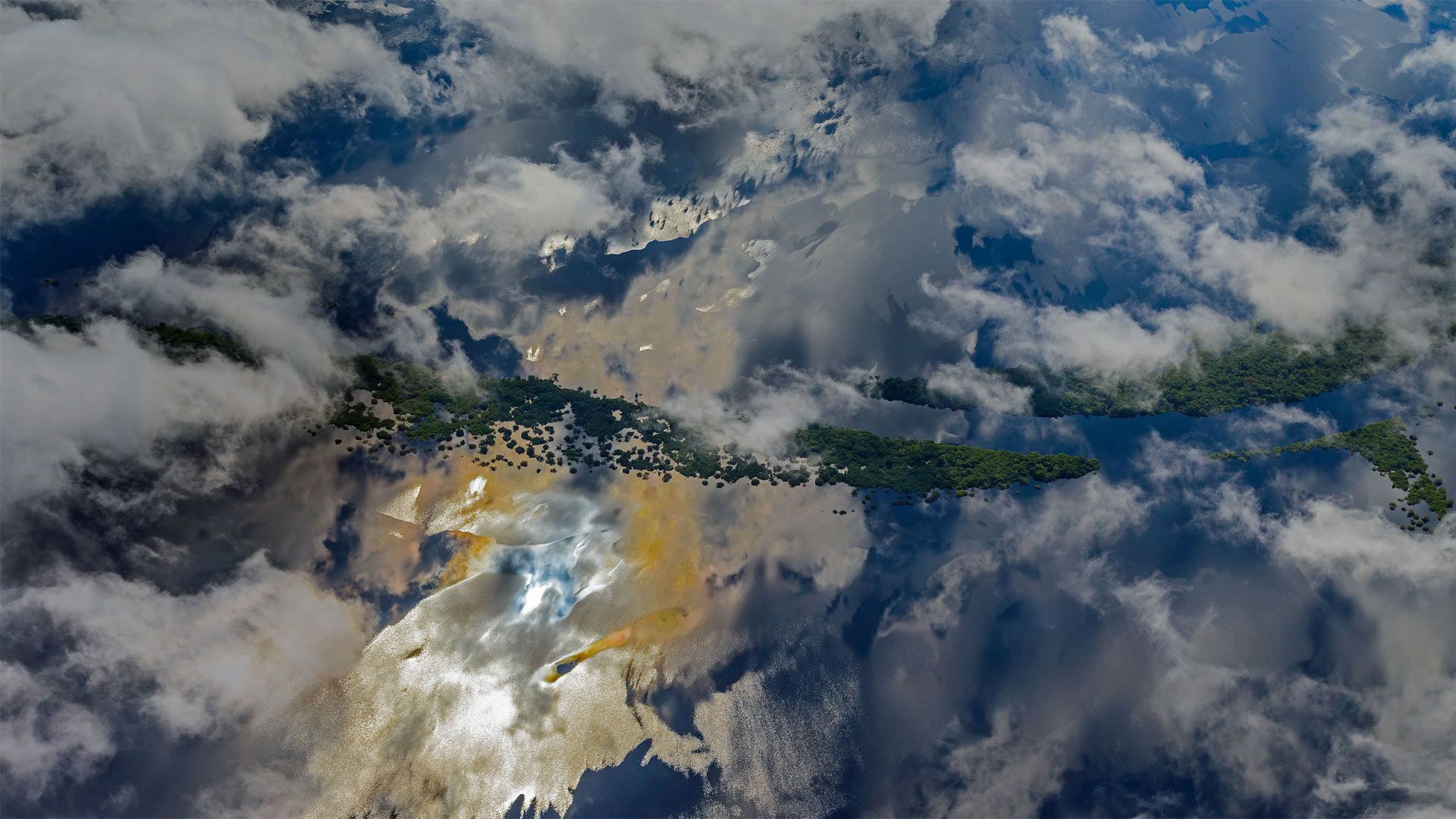
马瑙斯附近的亚马逊河流域鸟瞰图,巴西 Aerial of the Amazon River Basin near Manaus, Brazil (© Art Wolfe/Danita Delimont)
Reflections on the mighty Amazon
For World Rainforest Day we take you below these clouds to the Amazon River Basin and the largest rainforest in the world. At more than 2.1 million square miles, the Amazon accounts for half of Earth's remaining tropical rainforests. And a fifth of the world's freshwater flows through this river basin. Perhaps a tenth of the planet's known species call it home, many of which have yet to be identified—that's trees, plants, fish, mammals, and a third of Earth's bird species. Now take a deep breath. The ‘Lungs of the World' produces 20 percent of Earth's oxygen, while storing vast amounts of carbon dioxide, earning it an all-star ‘carbon sink' status.
Why's it called the Amazon? Spanish explorer and conquistador Francisco de Orellana gave it that name after encountering indigenous women of the Pira-tapuya tribe who fought alongside men. The women warriors of the region reminded Orellana of the Amazons of Greek mythology. Today, the Amazon rainforest still sounds almost mythologically powerful—and it is. Yet, all rainforests are fragile biosystems. Worldwide, we lose swaths of these precious environments to agriculture and mining. However, the pace of deforestation is slowing as farming methods improve and advocacy efforts build awareness around these rich bio-diverse tropical rainforests. The more we learn about rainforests, the more we appreciate how our own future, and the future of our planet, hinge upon their health.
